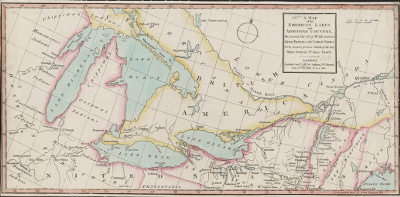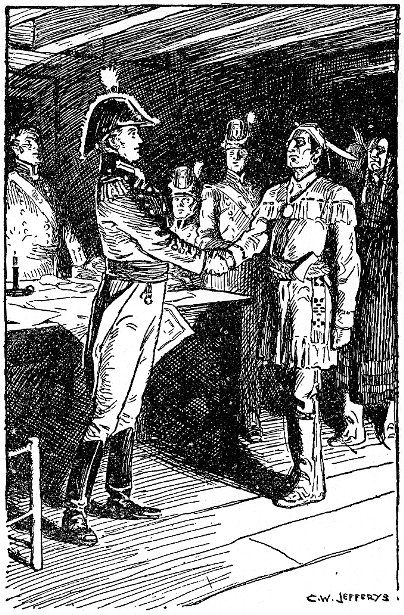War of 1812 History: 1812
As mentioned on the previous page, the United States declared war against Great Britain on June 18th, 1812. With that out of the way, the next question might be where to start hostilities. Since the main causes of the war as described in the declaration were due to British insults on the ocean, it may not be entirely intuitive that the Americans chose to concentrate their efforts as far away from the ocean as possible, on the remote western frontier of the province of Upper Canada, but that's what they decided. It makes some sense, though; Upper Canada made a pretty good target. In contrast to Great Britain's dominance of the seas, only a few thousand British Army regulars were located in the Canadas at the time. The population of Upper Canada in 1812 was around 80,000, spread across a vast area. Could the militia be of assistance? In theory, every able-bodied man in Upper Canada was part of the militia, but in practice, many of them didn't own stuff that we might consider essential for a militiaman, like guns, uniforms, or shoes. For several, pitchforks were the closest item to a weapon that they owned. Nor was it clear how dependable the militia would be. Some of the population of Upper Canada consisted of United Empire Loyalists and their offspring, who could be counted on to hate the Americans' guts. Just as many if not more, however, were Americans who came not so much to live under the British flag as for the cheap land, and who would be, at best, unenthused about fighting other Americans. At worst, they might be unconcerned whether Upper Canada was a British possession or an American one, resigned to the inevitability of Upper Canada falling to the United States, or even in the mood to co-operate with the invaders.
Fortunately, the British had other allies, in the form of the many Indian nations, especially those in the Northwestern United States. As these Indians had been fighting for the better part of a decade to prevent the United States from seiing their territory, while Britain had expressed the desire to have a neutral Indian nation formed in the northwest, it's only natural that the Indians would be allied with the British. The greatest of these Indians was Tecumseh, the Shawnee leader of a great Indian confederacy.
The Americans had been thinking ahead. On January 27th, 1812, they had appointed Henry Dearborn, who had a distinguished Revolutionary War career and later served as Secretary of War, as senior major general in command of the Northeast. Dearborn had put William Hull, Governor of the Michigan Territory, in charge of operations in Ohio and Michigan with the rank of Brigadier General, and Hull had several thousand troops that were ready to move on to Canada. However, this was 1812, so Madison couldn't call, e-mail, or text Hull to let him know that the war was a go. So, Hull didn't hear about the declaration of war until the 30th of June. Problem was, on the 29th, he had sent the schooner Cuyahoga from the estuary of the Miami River to Detroit, carrying his papers and other objects and some soldiers. Two days later the British seized it at Fort Malden. Hull's plans were valuable in helping the British formulate a plan of defence.
Another place where delays in communication proved fatal was at Fort Michilimackinac, often referred to as "Mackinaw" by those who don't have the time to spend saying "Michilimackinac". On July 17th, Captain Roberts marched from St. Joseph's Island with about 600 men in total. Lieutenant Porter Hanks, who was in charge at Mackinaw, got the surprise of his life when Roberts showed up and informed him that Hanks' country was at war with Roberts' country and, oh, could he surrender the fort, please? Hanks surrendered Michilimackinac without a fight.
By this time, Hull had made it to Detroit. After getting there, everyone else wanted to cross the river right away and capture Fort Malden, but Hull wanted to wait for orders from Washington. Once he finally got the orders, it turned out that they wanted him to cross the river right away and capture Fort Malden. By this time, however, Fort Malden had been reinforced, so that didn't seem like such a good idea anymore. So, on the 11th, Hull crossed over somewhere else, captured Sandwich, and on the next day issued a rather windy proclamation, stating that the Canadians would be "emancipated from Tyranny and Opression and restored to the dignified station of Freemen." Hull's soldiers, for their part, welcomed the Canadians to the Land of the Free by pillaging their farms. After a few inconclusive efforts in the direction of Fort Malden, Hull, who, due to a British ambush party, was having major problems getting supplies, decided to cross back over into the United States. Hull sent a party of men to break up the aforementioned ambush party. The two sides met at Maguaga on August 9th, where the Americans were driven back to Detroit.
On the 13th of August, Major-General Isaac Brock stepped ashore at Amherstburg, to take command personally of the British forces. Like Napoleon and Wellington, he was born in 1769 and on an island (specifically Guernsey, located in the English Channel between England and France). Unlike Napoleon and Wellington, however, Brock's destiny lay not on the battlefields of Europe, but in the backwoods of Upper Canada. Now Lieutenant-Governor of Upper Canada and commander of the forces in Upper Canada, he had been posted to Upper Canada for the past decade, where he had been preparing Upper Canada for the possibility of war, at least when he wasn't thwarted by the Parliament of Upper Canada, wherein those who wouldn't particularly mind an invasion of Upper Canada by the United States were quite well represented. Even just prior to Brock leaving York for Amherstburg, with an invasion imminent, these guys had been more interested in debating bills about education than in suspending the Habeas Corpus act per Brock's request, forcing Brock to prorogue Parliament and declare martial law.
Brock, after meeting with his officers and with Tecumseh, the great leader of a band of Indian warriors, decided to attack Detroit right away. Although outnumbered, Brock and Tecumseh put on a good show, and on the 16th the terrified Hull surrendered. With this surrender the territory of Michigan passed into British hands. Together with the capture of Michil..., um, Mackinaw and the capture of Fort Dearborn by Indians on August 9th, these victories had done much to convince both Indians and white Canadians that backing the British was not a losing bet.
The iron was hot, and it was time to strike decisively, either at Sackett's Harbour, or along the Niagara Frontier. Brock hurried back to Fort Erie on the Niagara frontier, only to find out that Sir George Prevost had negotiated a local armistice with Dearborn. The Orders-in-Council were been one of the big causes of the war; on June 16th, before the United States declared war (although there was no way for the news to reach the United States quickly), the British Foreign Minister announced that they would be relaxed, and the repeal happened on June 23rd. Prevost hoped that, after this news had reached Washington, perhaps the United States might reconsider war. Actually, the only effect that the armistice had was to allow Brock's advantage on the Niagara frontier evaporate as the Americans mobilized on their side of the Niagara River.
Sir George Prevost was the Governor-General of the Canadas and Commander-in-Chief of the British forces in North America. He would exemplify the Peter Principle over 150 years before the principle was first formulated. He had had an illustrious political and military career across British America, and had now worked his way to the top. By proposing the armistice, Prevost did interpret the wishes of Great Britain correctly, but he had allowed Dearborn to add the condition that movements of American men and materiel could continue along the fronts. The armistice, which only lasted for about a month, was only the first of several errors that Prevost would make over the next few years. We'll come to a few more of them later.
Along the American side of the Niagara frontier, command along the northern part of the Niagara River, at Fort Niagara and Lewiston, was held by General Stephen van Rensselaer. He was not a military man, nor was he particularly in favour of the war (he had been coerced into accepting the generalship). Luckily for him, he had a nephew, Colonel Solomon van Rensselaer, who did have some experience in this domain, and the General leaned on the Colonel for advice. To the south, at Buffalo, General Alexander Smyth was in charge. Like Hull and van Rensselaer, Smyth had obtained his position through political means and had little military experience. Van Rensselaer, under pressure from Dearborn to make things happen along the frontier, had big plans. However, Smyth wasn't interested in co-operating with Van Rensselaer's plans, and the militia weren't interested in invading a foreign country. So, Van Rensselaer chose to go it alone.
On October 13th, Van Rensselaer landed troops at Queenston. Colonel Van Rensselaer was injured almost as soon as he stepped ashore, rendering his assistance unavailable for the rest of the battle. At Fort George, Brock, who had received a knighthood the previous week but didn't know about it yet, galloped to Queenston, accompanied only by his aides. Once the Americans landed, Captain Wool led a few hundred infantry up-stream along a curved path that led to the top of Queenston Heights behind the British gun. Brock put together a small party consisting of what troops were available at Queenston, and made it to the Heights just as Wool arrived, forcing Brock to retreat downhill. Brock then decided to retake the Heights before reinforcements arrived. The gun was recaptured, but as success seemed certain, an American stepping out of a thicket shot Brock, who died almost instantly. Lieutenant-Colonel Macdonell then led another attempt to retake the Heights, but he too was mortally wounded. A few hours later General Sheaffe arrived from Fort George with reinforcements, and forced the Americans to surrender. However, the victory at Queenston could not make up for the loss of a talent of Brock's stature.
After the defeat at Queenston, van Rensselaer found it convenient to bow out of the picture, yielding command to Smyth. Smyth's main interests were in composing lofty proclamations, and in marching his soldiers to the Niagara River, changing his mind, and then marching them back, so it should come as no surprise that the Americans made no significant progress on that front for the rest of the year. Smyth was quietly dropped before the next season's campaign. He would later become a Congressman, and became so notorious for his long-winded, irrelevant speeches that other members of Congress would leave for the day the moment he got up to speak.
One area in which the Americans were having success was, surprisingly enough, at sea. On June 23rd, the President defeated the Belvidera, which only narrowly managed to escape. On August 19th, the Constitution captured the Guerriere. As well, American privateers did significant damage to British commerce. These actions were a significant nuisance, but they didn't have a significant effect on the course of the war. They did give the Americans something to feel good about, though. The many one-on-one battles that the Americans won also overshadowed the fact that the British, with their superior power at sea, were setting up a naval blockade of the United States.
On the diplomatic front, there were some efforts made towards peace. The major bone of contention was the Right of Search. The Americans couldn't live with it, and the British couldn't live without it, so that was that and the war continued.


![Sir George Prevost [Sir George Prevost]](/images/sir_george_prevost_psh_189_small.jpg)